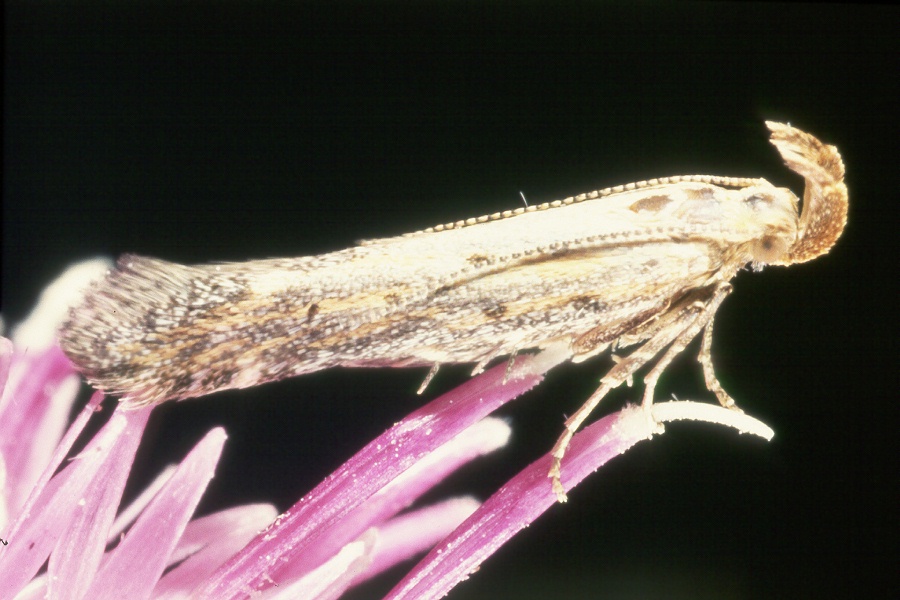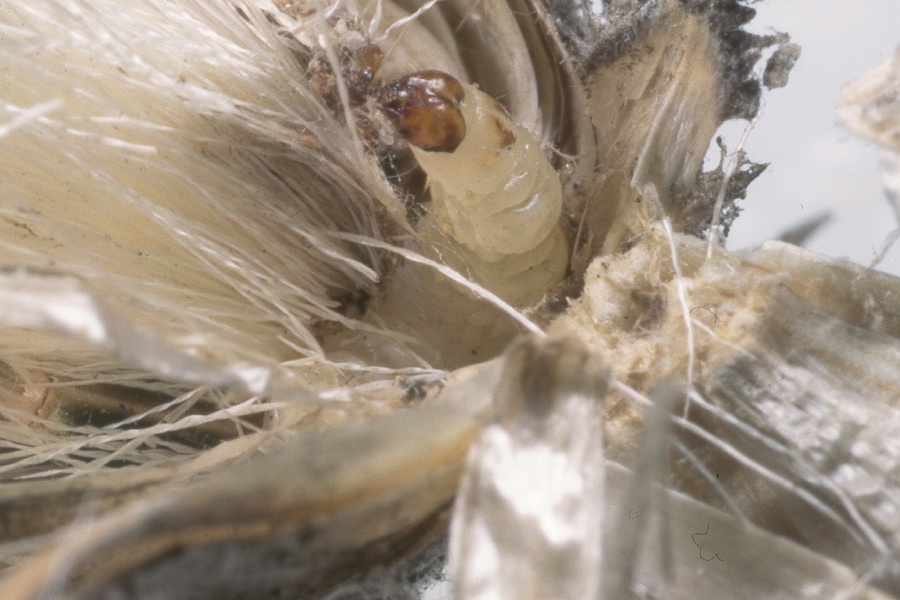Metzneria paucipunctella - spotted knapweed seed head moth. Insect, Lepidoptera: Gelechiidae
Pictures
Above: Adult moth. Below: larvae. Photos by Bob Richard, USDA-APHIS-PPQ.
Click on photos
Scientific name: Metzneria paucipunctella
Common Name: knapweed seed head moth (1,2)
Insect, Order, and Family: Insect, Lepidoptera: Gelechiidae (1,2)Origin: They originated from Switzerland. The native distribution was in Europe. (1)
Type of Agent: go to link 8.
Life Cycle:
Overwintering state: Mature larval (1)
Egg stage: Females lay 60-100 eggs during a three week period. This starts in June. The eggs are placed at the bottom of the knapweed flower heads or in the stem right underneath the head. The eggs tend to be a reddish-brown when they are first laid. they turn a yellowish color when they mature. The eggs are an oval shape and they are about 0.75 mm long. The incubation stage lasts for about 10 days. (1)
Larval stage: When the larvae first hatch they go into the open flower heads. The first-instar larvae eat the florets and the second-instar eat the seeds. The third-instar larvae go into the receptacle. This reduces the number of uneaten seeds. In other words they reduce the amount of seeds that survive. (2) Many larvae may be in the same seed head at one time. However, approximately one larvae will mature. Larvae normally have a brown head and their body is white in color. They are wrinkled at their abdominal segments. (1)
Pupal stage: Pupation takes place in the seed head during May.
Adult stage: The adults are generally 7 mm long. They fly only during dusk. (2) The adults rest with their wings folded over their back. Their front wings are gray with black spots and they have dark colored tips. Adults come out it June. (1)Effect:
Destructive Stages: Larval, seed head feeding. (1)
Plant species attacked: Spotted knapweed (1, 2) It also attacks diffuse knapweed. However, it doesn't attack diffuse as often. (1)
Damage to Host: The larvae feed on the seeds and they reduce the number of surviving seeds. They also damage the receptacle when they eat the seeds. (2) The older larvae will stick or web the seeds together. This prevents the seeds from spreading. (1,2) The moth will also attack the head. (1)Release habitats: They should be released in places that have a lot of good winter snow cover. This is essential to their survival. (1)
How to collect, transport, and redistribution:
Collection: The best way to collect Metzneria paucipunctella is to collect the seed heads in early spring from places where you have seen or previously confirmed the pupa and/or larvae. (2)
Transportation: They should be transferred in the larval/seed head or pupal stage (inside a cooler with an ice pack is good, you can also store them for a time in a refrigerator). (1)
Redistribution: The seed heads should be collected in the early spring. They should then be taken to the release site. This should be done before the adults emerge. You can put the seed heads in the refrigerator if you want to slow down or delay emergence. (1)Where to purchase: You can purchase Metzneria paucipunctella in Idaho, Montana, Oregon, and Washington. (1) See: http://mtwow.org/Purchase-Biological-Control-Agents.htm
Remarks: Metzneria paucipunctella is good at destroying spotted knapweed seeds. It will also attack diffuse knapweed. I feel that if these are released in the right place they should help lower the spotted knapweed population.
Links:
1) http://www.efn.org/~ipmpa/Noxknapw.html
2) http://www.nysaes.cornell.edu/ent/biocontrol/weedfeeders/metzneria_pauci.html
3) http://www.co.stevens.wa.us/weedboard/htm_bio/metzneria_p...
4) http://www.integratedweedcontrol.com/knapweed.htm
5) http://www.for.gov.bc.ca/hfp/noxious/Bioagents/Long/metzneri.htm
6) http://www.for.gov.bc.ca/hfp/noxious/Bioagents/Short/m1.htm
7) http://www.hysham.com/rosebudweed/newpage8.htm
8) http://el.erdc.usace.army.mil/pmis/biocontrol/html/metzneri.html
9) http://tncweeds.ucdavis.edu/esadocs/documnts/centmac.html
10) http://www.forestryimages.org/browse/detail.cfm?imgnum=0886052
Bibliography:
1) Rees, Norman, et. al., Ed., Biological Control of Weeds in the West, Western Society of Weed Science, in Cooperation with USDA ARS, MT Dept. of Ag. and MT State Univ., Color Printers, Bozeman, MT, Feb., 1996.2) Stevens County Noxious Weed Control Board, "Metzneria paucipunctella Knapweed Seed Head Moth." May 03, 2001 [Online] Available <http://www.co.stevens.wa.us/weedboard/htm_bio/metzneria_paucipunctella.htm>.
By: Carmen Uptmor, 02/03. Updated By: Amy Helling 04/05
Back to Biocontrol Main mtwow.org HOME Pictures
